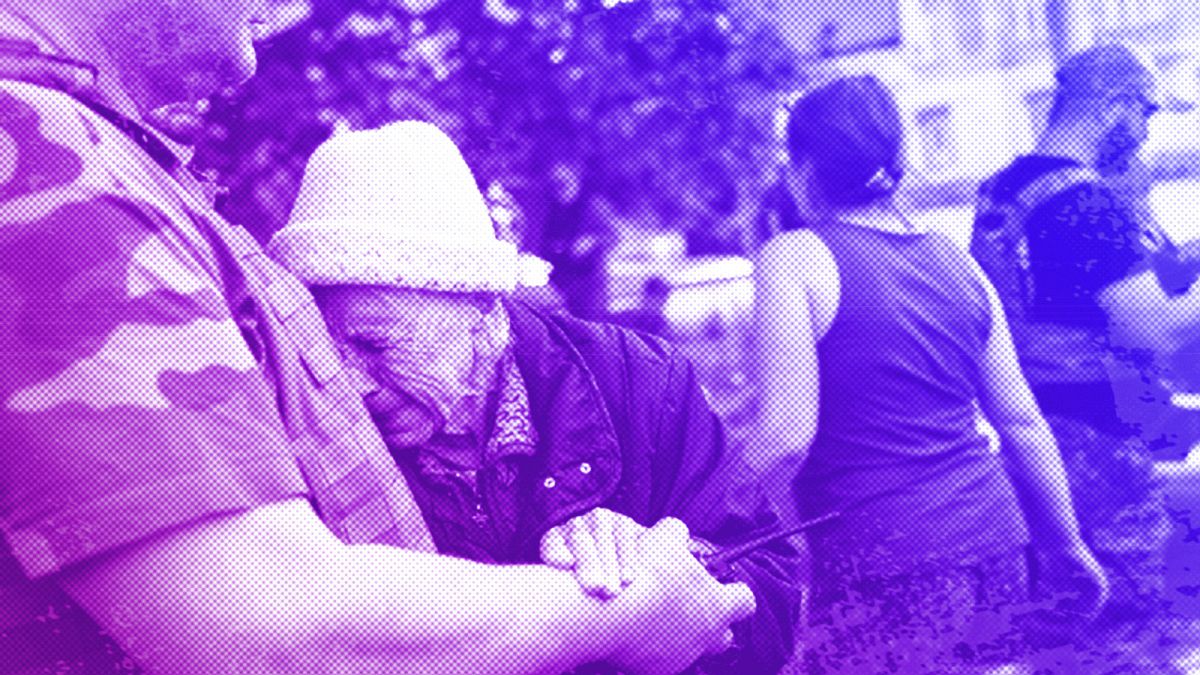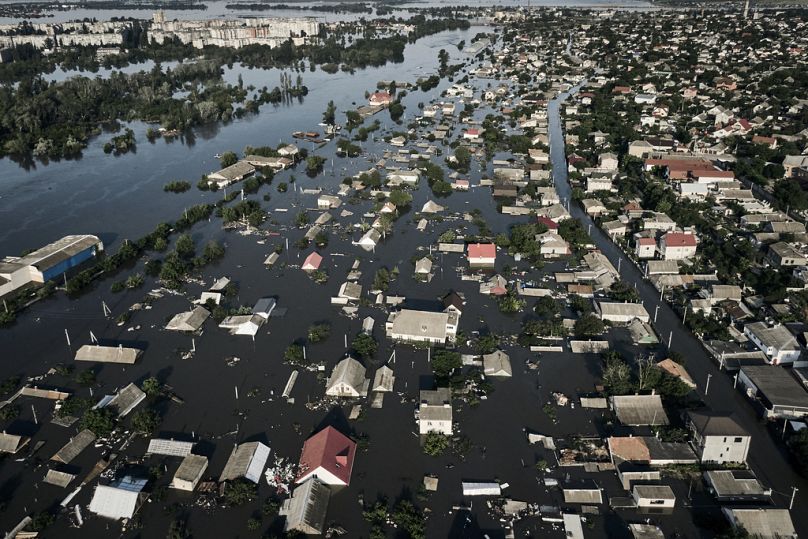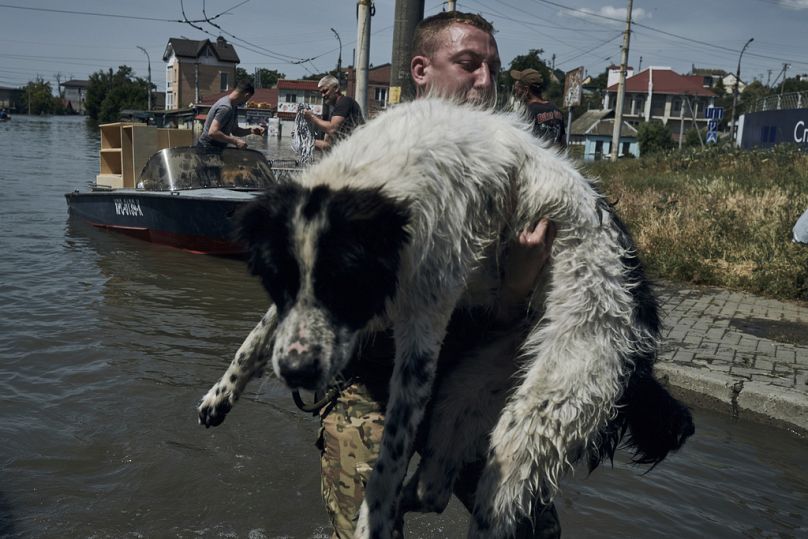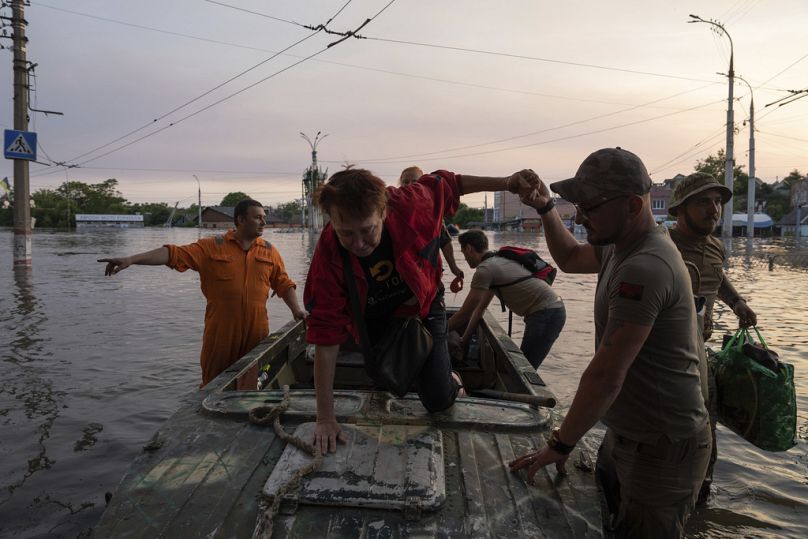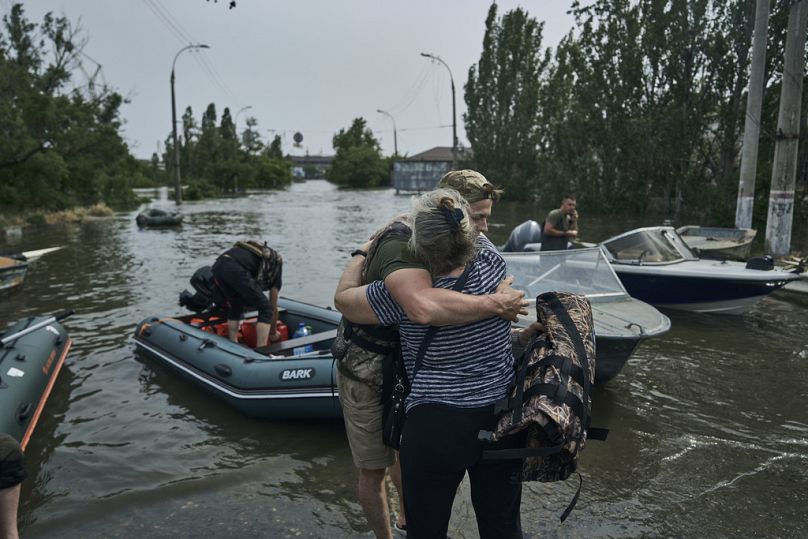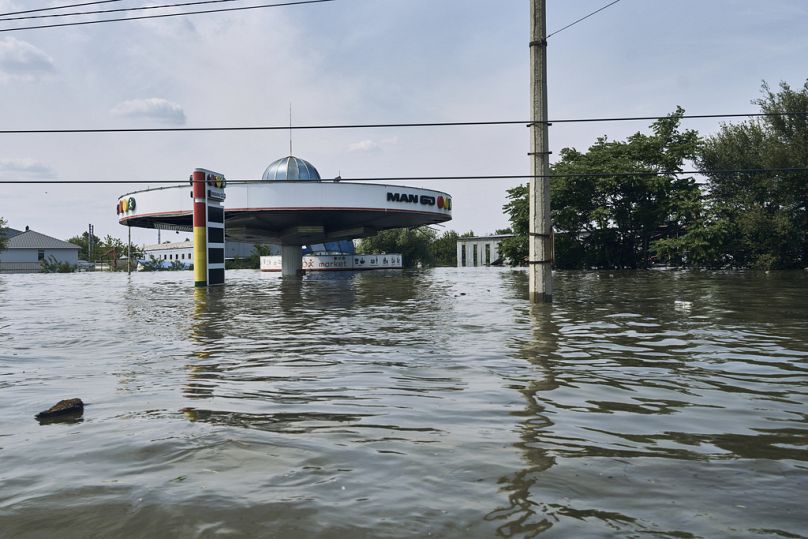As the vast and far-reaching consequences of the Kakhovka dam destruction become clearer, Euronews View spoke to Vsevolod Prokofiev, Save the Children’s Media Manager in Ukraine, who was among the first responders to the affected areas.
The true scale of the flooding caused by the breach of the southernmost dam on the Dnipro River reservoir cascade on Tuesday is slowly becoming clear.
Officials said more than 6,000 people have been evacuated by Thursday from dozens of flooded cities, towns and villages on both sides of the Dnipro River, which has become part of the front line since Russia’s full-scale invasion in February last year.
Some 40,000 in total need to leave, according to Ukrainian authorities.
The collapse of the Kakhovka hydroelectric dam and the emptying of its reservoir — which the locals sometimes refer to as the Kakhovka Sea due to its immense size —has added to the misery that the region has suffered for more than a year from artillery and missile attacks.
The city of Kherson, which was liberated by the Ukrainian Armed Forces on 11 November 2022, was again shelled by the Russian troops on Thursday amid ongoing evacuations, compounding the terror felt by both the local population and Ukrainians who fled from other areas of the country in search of safety elsewhere.
Meanwhile, the Kremlin has been slammed for the destruction of the dam after Western intelligence sources claimed the Russian forces committed a deliberate attack.
A number of EU officials, including European Commission President Ursula von Der Leyen, condemned the act as a “war crime” and “an outrageous attack on civilian infrastructure”. Moscow has, in turn, laid the blame on Kyiv.
Since the dam’s collapse and the resulting flooding, domestic and international humanitarian aid organisations have been working tirelessly together with local authorities to help those in imminent need of assistance.
Euronews View spoke with Vsevolod Prokofiev, Save the Children’s Media Manager in Ukraine, who was among the first responders to the affected areas.
Euronews View: You are currently a part of the effort to help those who have been affected by the destruction of the dam. Could you tell us a little bit more about what you encountered on the ground there?
Vsevolod Prokofiev: The situation on the ground is changing rapidly. It's quite unpredictable. The flood wave seems to be no longer arriving, but still, vast areas are flooded -- about 30% of the right bank of the Kherson region, as pointed out by local administrations.
We have seen around 2,000 people get evacuated, and more than 100 children among them. Most of them are residents of Kherson city itself.
But what we see with the displacement is that people are not willing to move too far.
They are definitely tired of the displacement because many of them had to flee when the war unravelled in February last year, and now they are not ready for another long-term movement.
They tend to move to different accommodations inside Kherson city or to the nearest villages where they have friends or relatives or are just able to find spare housing.
They are not even going to the neighbouring oblasts like Mykolaiv. We have seen only like 100 people or 50 families arriving there and not many children at all.
So the whole picture of displacement is that it's been very, very difficult, and people tend to stay where they are, just moving to a safer place within one town.
Euronews View: Could you describe the scale of the devastation that you're witnessing?
Vsevolod Prokofiev: It's hard for me to draw comparisons, but in the most flooded areas, you would see houses literally completely covered with water and only the roof sticking out.
So basically, we have seen pictures and videos popping up on social media that people, families with children, at some point were rescued from the rooftops of their houses.
We also heard from families that were alarmed by their neighbours early in the morning, basically rushed from their beds, picked up only a few belongings picked up only basic documents like IDs for them and their children, and fled to safer places because the water had already started coming to their homes.
And that is not only including those detached houses that were submerged by the water completely, but the multi-story buildings as well that in some locations have almost entire first stories covered in water.
Euronews View: Speaking of Kherson, the city has been the epicentre of very intense and destructive fighting followed by constant attacks by the Russian troops. And. now this happened. How do people who live in Kherson perceive this disaster?
Vsevolod Prokofiev: It is quite a peculiar thing about not only this particular situation with flooding in constant shelling going on only in Kherson and its neighbourhood, but people are being very resilient. They are helping one another.
It is almost every time a collective effort of local volunteers, international organisations, and people themselves to be able to rescue themselves, their neighbours, and their friends.
One family I talked to personally told me they were able to escape only because an unknown girl offered them a ride in her car. That's how they moved out of the flat.
People have experienced gruesome crimes, these gruesome events, starting with shelling, active fighting and now this dam catastrophe, but they are holding up; they're not losing strength.
They're not losing hope that the situation is going to become better very soon. Many of them expect in a week or so when the water goes down to return to their original homes.
And this is when we will probably see this crisis with the dam destruction unravel in a slightly different way because we will see people's housing or conditions therein and whether people are able to return or will they need to stay in a different place.
Will they be basically displaced once again, will they need assistance with renting accommodation, livelihood, food and water?
Euronews View: What kind of needs are you and other humanitarian aid organisations registering and responding to at the moment?
Vsevolod Prokofiev: We are right now in a village just 20 kilometres away from Kherson.
It is not yet directly affected by floods, but people are very worried about the fact that water might come or the after-effects of this whole flood.
And the big thing is that there is no major water pipeline because almost 90% of all housing and essential facilities here are literally completely destroyed, and so people are surviving only with food brought by volunteers and humanitarian workers.
The same situation is with water. The very best they might get is 12 litres per household for an entire week.
So now we are bringing a truck full of water able to cover each and every household here, and this is the refillable option. We will now hand out bottles, people will empty them, and bring them back to the local administrations. We will then recollect them, refill and bring them back out again.
Aside from water delivery, we are also doing cash registration. So basically, those people who have been displaced by this flood, we are about to give them cash assistance to cover basic needs like for water and also a separate payment for accommodation purposes.
So if they are going to be displaced long term so they could afford one or two months of rent for their new place.
We are in constant communication with our humanitarian colleagues and local administrations, and as the situation is changing rapidly, the response might expand as well.
Euronews View: What are some of the more hidden dangers of the flooding that came after the destruction of the dam that the people might not be aware of outside of Ukraine or outside of that region?
Vsevolod Prokofiev: Well, the hidden dangers are quite obvious, and people here, the locals, know them very well.
Number one, I've just talked to the father of two children, who told me that the water basically washed away all courtyards.
Not only the ones used by people but for cattle as well, so everything that was under the ground is now being brought up to the surface.
Once the water levels subside, this debris will stay on the ground and potentially become a source of infection and of diseases. People are very worried about this here.
Another problem is the mines and unexploded ordinance. Water is bringing them up with the flood, so already highly contaminated areas are becoming even more dangerous.
Also, the most vulnerable communities that are at the bank of the river -- the humanitarian access there with evacuation efforts and humanitarian aid like food and water are impaired.
We were going to visit one village on the bank of the river, and the road there is currently washed away and filled with mines brought by water, so we were not able to reach it.
The lack of drinking water is another potential threat because we see now the Kakhovka reservoir rapidly swallowing.
So at some point, there might just not be enough water for pump stations to be able to transport it to the cities, and we know that a lot of towns and villages in the Dnipro region, the Zaporzhizhia region and the Kherson region, they drew water precisely from this reservoir.
So essentially, mass water shortages are another major concern.
At Euronews, we believe all views matter. Contact us at view@euronews.com to send pitches or submissions and be part of the conversation.
